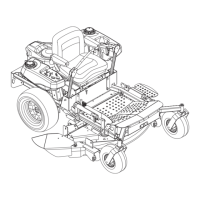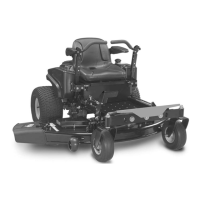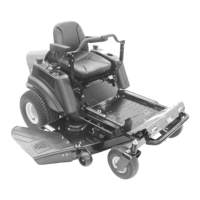GB - 14
STOPPING
Brake Operation
This tractor uses hydrostatic braking, through the
transmission, to slow the tractor.
Stopping the Ground Drive
• Bring Steering-Control Levers back toward
neutral to slow the tractor.
• To stop the tractor drive, move the
Steering-Control Levers into the neutral position.
Stopping the Engine
• Move throttle control to slow position and allow
engine to idle for 30 seconds.
NOTE: Failure to move throttle control to slow position
and allowing engine to idle before stopping may cause
engine to "Backfire".
• Turn ignition key to "OFF" position and remove
key. Always remove key when leaving tractor to
prevent unauthorized use.
IMPORTANT: Leaving the ignition in any other position
than "OFF" will cause the battery to be discharged.
NOTE: Under conditions when tractor is standing idle
with the engine running, hot engine exhaust gases may
cause "browning" of grass. To eliminate this possibility,
always stop engine when stopping tractor on grass
areas.
TO TRANSPORT THE MOWER
IMPORTANT: Never push or pull (tow) the unit with
another vehicle. Use a truck or trailer when
transporting or transmission damage can occur.
• Disengage PTO.
• Raise attachment lift to highest position with
attachment lift control.
• When pushing your tractor, be sure the
transmission dump valves are OPEN.
• Do not push tractor at more than five (5) mph.
• To protect engine cover when transporting your
tractor on a truck or a trailer, be sure engine cover
is closed and secured to tractor. Use an
appropriate means of tying hood to tractor (rope,
cord, etc.).
FOR BEST MOWING RESULTS
• Mower should be properly leveled for best
mowing performance. See Deck Leveling in
Service and Adjustments.
• The left side of mower should be used for
trimming.
• Drive so that clippings are discharged onto the
area that has been cut. Keep the cut area to the
right of the machine. This will result in a more
even distribution of clippings and more uniform
cut.
• When mowing large areas, start by turning to the
right so the clippings will discharge away from
shrubs, fences, driveways, etc. After one or two
rounds, mow in the opposite direction making left
hand turns until finished.
• If grass is extremely tall, it should be mowed
twice to reduce load and possible fire hazard from
dried clippings. Make first cut relatively high; the
second to the desired height.
• Do not mow when grass is wet. Wet grass will
clog mower and leave undesirable clumps. Allow
grass to dry before mowing.
• Always operate engine at full throttle when
mowing to assure better mowing performance
and proper discharge of material. Regulate
ground speed by using the Steering Control
Levers.
• When operating attachments, select a ground
speed that will suit the terrain and give best
performance of the attachment being used.
MULCHING OPERATION (OPTIONAL)
The special mulching blades and baffles will allow the
grass clippings to be cut many times to reduce their
size. As the grass falls onto the lawn, it disperses into
the grass and will not be noticed. Also, the mulched
grass biodegrades quickly and provides nutrients for
the lawn.
• Always operate engine at full throttle when
mulching to assure the best cutting action of the
blades.
• For best performance, set the height of your
mower deck so that no more than 1/3 of the total
grass length is removed at any one time.
• Grass should be cut when it is dry, not when it is
wet from dew, rain or from watering. Wet grass
tends to pack inside mower pan and will not
disperse evenly.
• If grass does not disperse evenly, it is possible
that too much grass is being removed per cutting,
grass is too wet or travel speed is too fast.
• This mulcher is not recommended for newly
seeded lawns. A new lawn has much softer
blades of grass and a higher moisture content.
New lawns should be cut with conventional side
discharge or bagging for the first few mowings.
CAUTION: Always stop tractor completely, as
described above, before leaving the operator’s
position for any reason.

